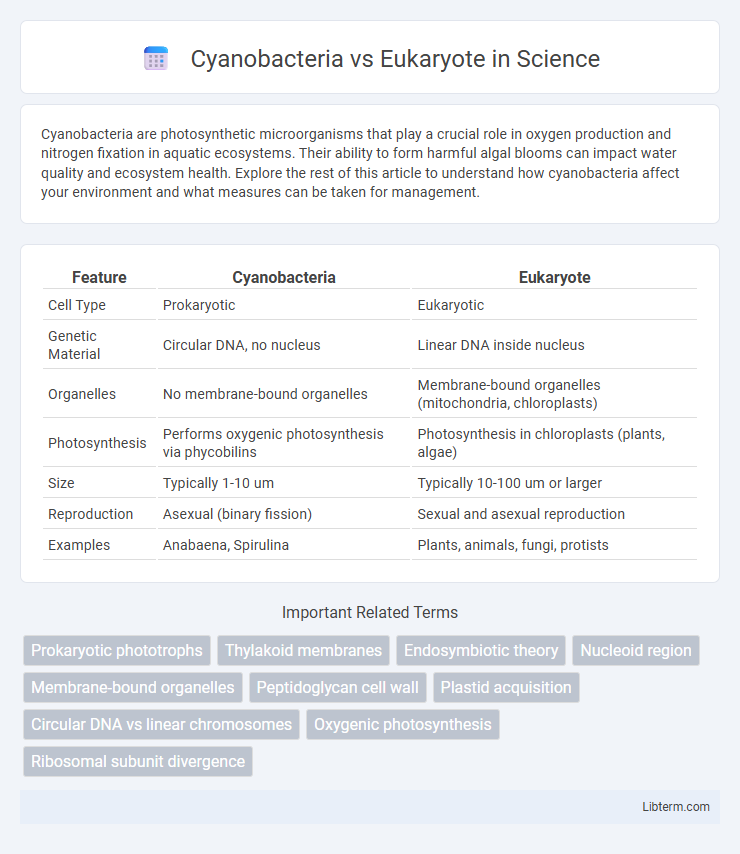Cyanobacteria are photosynthetic microorganisms that play a crucial role in oxygen production and nitrogen fixation in aquatic ecosystems. Their ability to form harmful algal blooms can impact water quality and ecosystem health. Explore the rest of this article to understand how cyanobacteria affect your environment and what measures can be taken for management.
Table of Comparison
| Feature | Cyanobacteria | Eukaryote |
|---|---|---|
| Cell Type | Prokaryotic | Eukaryotic |
| Genetic Material | Circular DNA, no nucleus | Linear DNA inside nucleus |
| Organelles | No membrane-bound organelles | Membrane-bound organelles (mitochondria, chloroplasts) |
| Photosynthesis | Performs oxygenic photosynthesis via phycobilins | Photosynthesis in chloroplasts (plants, algae) |
| Size | Typically 1-10 um | Typically 10-100 um or larger |
| Reproduction | Asexual (binary fission) | Sexual and asexual reproduction |
| Examples | Anabaena, Spirulina | Plants, animals, fungi, protists |
Introduction to Cyanobacteria and Eukaryotes
Cyanobacteria are photosynthetic prokaryotes characterized by their ability to perform oxygenic photosynthesis using thylakoid membranes, contributing significantly to global oxygen production and nitrogen fixation. Eukaryotes possess membrane-bound organelles, including a nucleus, mitochondria, and chloroplasts in photosynthetic species, enabling compartmentalized metabolic processes and complex cellular functions. The endosymbiotic origin of chloroplasts in eukaryotic photosynthetic organisms traces back to ancestral cyanobacteria, highlighting their evolutionary connection.
Evolutionary Origins and History
Cyanobacteria are ancient prokaryotic organisms that appeared over 2.5 billion years ago and are crucial for oxygenating Earth's atmosphere through photosynthesis. Eukaryotes evolved approximately 1.5 billion years ago, likely originating from a symbiotic event where an ancestral archaeon engulfed a cyanobacteria-like prokaryote, leading to the formation of mitochondria and chloroplasts. This endosymbiotic theory highlights the evolutionary link between cyanobacteria and eukaryotic cells, emphasizing cyanobacteria's pivotal role in shaping complex life.
Structural Differences
Cyanobacteria possess prokaryotic cell structures characterized by the absence of membrane-bound organelles and a nucleoid region containing circular DNA, whereas eukaryotes have complex cells with membrane-bound organelles, including a defined nucleus housing linear DNA. Cyanobacteria contain thylakoid membranes for photosynthesis dispersed within the cytoplasm, while eukaryotic photosynthetic cells have chloroplasts with organized thylakoid stacks. The cell walls of cyanobacteria are typically peptidoglycan-based, contrasting with the diverse polysaccharide-based cell walls or extracellular matrices found in eukaryotic cells.
Genetic Material and Genome Organization
Cyanobacteria possess a single, circular chromosome located in the nucleoid region, lacking membrane-bound organelles, while eukaryotes have multiple linear chromosomes enclosed within a nuclear membrane. The cyanobacterial genome is typically smaller, ranging from 1.5 to 10 million base pairs, compared to the vast and complex eukaryotic genome, which can exceed billions of base pairs with extensive non-coding regions. Gene organization in cyanobacteria often features operons allowing coordinated expression, whereas eukaryotic genes are usually regulated individually with introns and exons requiring RNA splicing.
Modes of Reproduction
Cyanobacteria reproduce primarily through binary fission, a simple asexual process enabling rapid population growth in aquatic environments. Eukaryotes exhibit diverse modes of reproduction, including mitosis for asexual reproduction and meiosis followed by sexual reproduction, promoting genetic diversity. The fundamental difference lies in cyanobacteria's prokaryotic cell division compared to the complex cell cycle and genetic recombination mechanisms in eukaryotic organisms.
Cellular Organization and Organelles
Cyanobacteria exhibit a prokaryotic cellular organization, lacking membrane-bound organelles and possessing thylakoid membranes within the cytoplasm for photosynthesis. Eukaryotes feature a complex cellular structure with membrane-bound organelles including a nucleus, mitochondria, chloroplasts (in photosynthetic species), and an endoplasmic reticulum. The presence of internal compartmentalization in eukaryotic cells allows for specialized metabolic processes, which contrasts with the more generalized cytoplasmic functions in cyanobacteria.
Metabolic Processes and Energy Production
Cyanobacteria perform oxygenic photosynthesis using thylakoid membranes, capturing light energy to convert CO2 into organic compounds while releasing oxygen, relying on photosystem I and II. Eukaryotes utilize mitochondria for aerobic respiration, breaking down glucose via glycolysis, the Krebs cycle, and oxidative phosphorylation to produce ATP efficiently. Unlike eukaryotes, cyanobacteria can fix atmospheric nitrogen through specialized heterocysts, integrating metabolism for both energy production and nitrogen assimilation in diverse environments.
Ecological Roles and Habitats
Cyanobacteria thrive in diverse aquatic and terrestrial habitats, playing critical roles in nitrogen fixation and oxygen production, which support ecosystem productivity and biogeochemical cycles. Eukaryotes occupy a wider range of ecological niches, from aquatic environments to soil and multicellular habitats, contributing to complex food webs and nutrient cycling. Both groups influence global carbon and nitrogen cycles but differ in cellular complexity and ecological specialization.
Impact on Human Life and Biotechnology
Cyanobacteria contribute significantly to biotechnology through their ability to perform oxygenic photosynthesis, producing biofuels, bioplastics, and valuable pharmaceuticals, while also playing a crucial role in nitrogen fixation which benefits agriculture. Eukaryotes, especially engineered yeasts and algae, are vital in producing medicines, enzymes, and biofuels, supporting industrial and medical advancements. Both cyanobacteria and eukaryotic organisms influence human life by enhancing sustainable resource production and offering solutions for environmental challenges.
Future Research and Scientific Implications
Future research on cyanobacteria and eukaryotes will focus on metabolic engineering to enhance biofuel production and carbon capture technologies. Understanding the genetic and biochemical distinctions between cyanobacterial photosynthesis and eukaryotic cellular processes could unlock novel applications in synthetic biology and climate change mitigation. Integrating multi-omics approaches will accelerate discoveries in evolutionary biology and environmental sustainability.
Cyanobacteria Infographic

 libterm.com
libterm.com